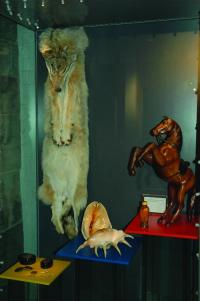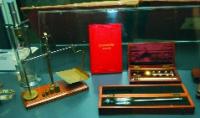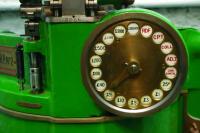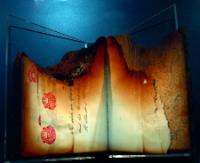Museum eye:Revenue Museum/Músaem Ioncaim Chapel crypt, Dublin Castle www.revenue.ie/en/about/revenue-museum.html, +353 (0)1 8635 601 Mon.–Fri. 10am–4pm by Tony Canavan
Published in 18th–19th - Century History, 20th-century / Contemporary History, Early Modern History (1500–1700), General, Issue 3 (May/June 2011), Medieval History (pre-1500), Reviews, Volume 19
A cabinet displaying items seized by customs officers under the terms of the Convention on International Trade in Endangered Species (CITES).
The Revenue Museum recently featured in a book about the government’s waste of taxpayers’ money but this seems an unfair criticism of an interesting and well-presented exhibition. Sited in the atmospheric crypt of Dublin Castle’s chapel, it occupies a small chamber that makes the best use of its space. As soon as you go through the door there is a sign telling you where to start, and you go round in a circle following the story of tax-collecting from the early kings of Ireland to the present day.The museum has many display cabinets full of historical items, some of them seized by revenue officers in the past. There are also videos running at various points that illustrate some aspect of the Revenue’s history. In the section called ‘The Old Reliable’ I particularly enjoyed the instructive film on the making of poitín, and if you saw the seized still on display you would certainly have second thoughts about drinking the stuff. Added to this there are also a couple of simple video games in which you have to find hidden contraband or spot taxable goods in different scenarios. One unusual feature is that laminated cards rather than the more conventional labels are provided to explain the numbered items in the cabinets.One criticism may be that the information panels throughout the exhibition are wordy and the modern visitor may not have the patience to read them. That would be a pity, as they give a potted history of Ireland through taxation, which is more interesting than it sounds. Ancient kings collected taxes, usually in the form of cattle or crops, and in the medieval period High King Brian Ború (Brian Bóroimhe, ‘Brian of the tributes’) became notorious for his tax-collecting. Later the English introduced new kinds of tax and established a formal revenue service in the seventeenth century, which laid the foundations for today’s Revenue Commissioners.

A hydrometer used to measure the alcohol content of spirits, on which the charge of excise duty was based.
The three big events for revenue in Ireland were the Act of Union, which abolished the Irish parliament; independence, which created an indigenous revenue system; and joining the Common Market (the EU today), which revolutionised cross-border taxation.Another fascinating aspect of the museum is the variety of goods that were taxed over the centuries. We are all familiar with duty on alcohol and tobacco, but in the past revenue was raised on dice, coaches, silver plate, tea and coffee, curtains, and even on hearths and windows. Of course every tax imposed met with evasion, and a lot of the museum is taken up with how revenue and customs officers attempted to catch smugglers, counterfeiters and illegal distillers. They once had their own

Close-up of a stamping machine used up to the mid-1990s to impress stamp duty stamps on various legal documents.
police force, a uniform of which is on display, and to this day have their own cutter to intercept vessels at sea.Among the exhibits to look out for is a variety of goods confiscated in modern times (such as skins, feathers and shells of endangered species), stamp books and various items of equipment that the Revenue have used for centuries like tape measures, scales, safes, adding machines, hydrometers and ‘tuck sticks’. How customs and revenue featured in our history in another way is illustrated by the burnt remains of a stamp book. It is a relic of the IRA attack on Dublin’s Custom House in 1921. This was a key moment in the War of Independence, as the IRA had been ordered to show its capacity to wage war on a large scale.

A partially burned book of stamps rescued from the ruins of the Custom House in 1921.
(All images: Revenue Museum)
The Custom House was a symbol of British rule in Ireland, and the Revenue Commissioners themselves symbolise national sovereignty. A good part of the museum shows their work since independence in collecting customs dues and thwarting tax-dodgers. A major issue was the newly drawn border with Northern Ireland. I was amused at the somewhat po-faced attitude to minor cross-border smuggling in the war years but it was interesting to see the official view of an activity that has entered into folklore. There is a video of the customs posts on the border and the officers carrying out their tasks prior to the establishment of the Single Market. On the other hand, much of the smuggling and counterfeiting that goes on is serious and not only deprives the state of funds but can endanger lives.We are brought up to date with displays on the current work of the Revenue. This involves attempts to intercept smugglers of drugs, tobacco and counterfeit goods. Many of these are to be seen in the cabinets alongside some of the ingenious methods used to sneak them into the state, such as a fake beer can, a hollowed-out book and a cuddly toy with its stuffing replaced by tobacco. The personnel of the service are not forgotten. We are reminded that in the past it was a dangerous occupation; smugglers and poteen-makers used violence to resist them, and revenue officers had to be armed with rifle and sword (examples on display). There is also the chance to hear recordings of some actual customs officers as they recount anecdotes from their careers. Another side of revenue officers is highlighted in the brief information on the number of writers who emerged from the service, such as Padraic Fallon and Maurice Walsh (of The Quiet Man fame).Tucked away in an obscure part of Dublin Castle, this museum is worth seeking out. Some Spanish visitors were there the day I went and they seemed genuinely interested in it. Taxes are something we must all pay but either take for granted or simply resent, yet the history of taxes and tax collection tells us much about the history of Ireland. The type of taxes sought by kings and governments over the centuries reflects the development of Irish society, the centralisation of government and the emergence of the modern state. One panel points out that complaints about taxes were central to the American and French revolutions. Add to this the oddities on display and the human story of the taxmen and you have a small but entertaining museum and certainly not a waste of taxpayers’ money. HI
















